#ancient Norway
Explore tagged Tumblr posts
Text
This is absolutely nuts. Who in the world would okay this?
17 notes
·
View notes
Text
youtube
The Son of Thor Who Saved His Father at Just Three Days Old!
Did you know that Thor has three legendary children? Discover who they are and what makes them extraordinary!
Did you know that Thor, the god of thunder, has three unique children? Magni, with his superhuman strength, saved his father as a newborn. Móði, the embodiment of courage, is destined to lead the new world after Ragnarök. Þrúðr, his valkyrie daughter, is a warrior as powerful as she is captivating. Each of them represents a divine quality that makes them essential to Asgard's fate. Get ready to uncover their deeds and their roles in the most epic Norse legends!
#Thor#children of Thor#Magni#Móði#Þrúðr#Norse mythology#Ragnarök#Sif#Járnsaxa#Norse giants#Norse gods#Norse legends#Magni strength#Móði courage#Þrúðr valkyrie#mythology#Norse history#ancient Norway#Viking myths#Youtube
0 notes
Text
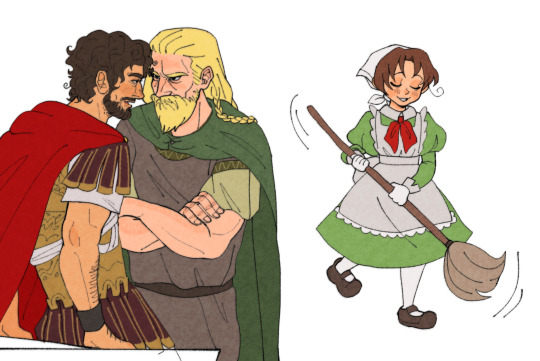


220 notes
·
View notes
Text

Viking Silver Bracelet Hoard Found in Norway
Archaeologists have unearthed a set of uniquely decorated bracelets on the site of a "large and powerful" Viking Age farm.
Archaeologists in Norway have discovered a Viking Age treasure that had remained "untouched" for more than 1,000 years.
The four silver bracelets had been buried nearly 8 inches (20 centimeters) in the ground on a mountainside in Årdal, a village in southwestern Norway, according to a translated statement from the University of Stavanger.
"This is definitely the biggest thing I have experienced in my career," Volker Demuth, an archaeologist and project manager at the Archaeological Museum at the University of Stavanger, said in the statement.
Archaeologists found the bracelets ahead of construction of a new tractor road.
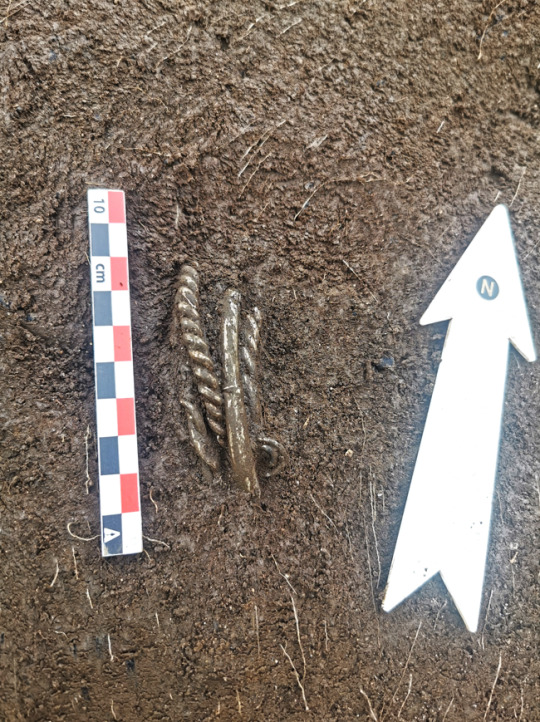

Further exploration revealed that the location once housed a "large and powerful" Viking Age (A.D. 793 to 1066) farm comprising multiple houses for people and animals, according to the statement. The researchers found the buried bracelets within one of the smaller structures, which likely housed enslaved individuals.
In addition to the jewelry, researchers discovered an array of artifacts, including soapstone pots, rivets, knife blades and whetstones for sharpening tools. There's also evidence that the farm had been burned down, which "coincides with a period of great unrest in the Viking Age," according to the statement.
"If people who lived on this farm had to flee from an attack, it would be natural to hide away the valuables you had before escaping to the mountains," Demuth said. "And perhaps in a place where you would not have thought that a treasure was hidden."
By Jennifer Nalewicki.


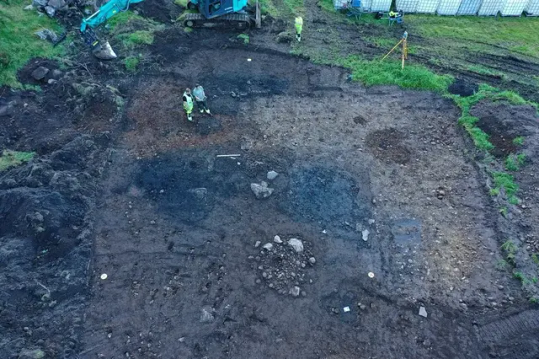
#Viking Silver Bracelet Hoard Found in Norway#Årdal#silver#silver jewelry#ancient jewelry#ancient artifacts#archeology#archeolgst#history#history news#ancient history#ancient culture#ancient civilizations#viking history#ancient art#art history
243 notes
·
View notes
Text

I finally finished this! I'm putting the full images under the cut for better quality, but this was fun! It also challenged me to draw a lot of Scotland
There is also a bonus Rome & Mama Greece:

Thank you to @breitzbachbea @pvffinsdaisies @the-phoenix-heart @moderngamebantam and @acedormouse for the suggestions!


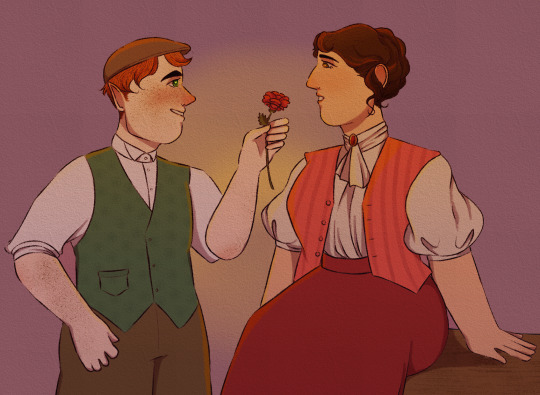

#hetalia#my art#hws scotland#hws france#hws ukraine#hws canada#hws ireland#canon ireland#nyotalia#nyo!romano#hws norway#hws rome#hws ancient greece#hws mama greece#scotfra#canukr#iremano#scotnor#imperial pair#that's the name i'm giving mama greece and rome idk a proper name for them#4 ships challenge#this was so fun!!#this made me realize i don't draw ukraine nearly enough she is such a queen
66 notes
·
View notes
Text
An important find
161 notes
·
View notes
Text

2025 / 11
Aperçu of the week
"Power to the people, right on."
(John Lennon - nothing more to add here)
Bad News of the Week
I must already assume that the decline of the United States of America under Donald Trump will dominate my bad news this year. Not because there is a lack of other bad news that enlightened people have to deal with. It's simply because so much is going so wrong in our former role model country that it seems more monstrous than so much else. Even in a week in which the civil war in Syria is rearing its ugly head again, the ceasefire in Gaza is becoming more fragile and the Kremlin is still destroying Ukraine.
Donald Trump resembles an ancient god of vengeance who arbitrarily punishes anyone who does not pay him proper homage or question his genius. He clearly suffers from narcissism, which is a serious mental disorder and not just a strange self-image. In his infallibility, he assumes that anyone who doesn't see his personal standards, which are unfortunately anything but democratic, as the ultimate, is simply too stupid. Or malicious or ungrateful. And so he throws his lightning bolts from the Olympus of the Oval Office down on unworthy earthlings.
He is so predictable that he can easily be instrumentalized by those close to him. For example, Elon Musk, who persuaded him to promote Tesla, which was of course not a personal favor, but merely an underlining of the economic policy dogma that a good American must of course drive an American car. Or from JD Vance, who remarked that he had not yet received enough recognition that day and was therefore able to throw Volodymyr Selensky under the bus with a single perfidious sentence about his alleged lack of gratitude. After just two months in office (although you can't really say that about Musk), both of them have been certified as puppet masters.
It is now completely unclear whose interests are behind three seemingly harmless trifles that Trump has initiated in recent days. He puts Bhutan, a tiny peaceful Buddhist country in the Himalayas, on the list of red states, from where nobody is allowed to enter the US - just besides Afghanistan and Yemen. He invokes the Alien Enemies Act from 1798 to deport hundreds to El Salvador - despite a federal judge ruling a restraining order against it. He puts words like “climate crisis” or “indigenous people” on a list of 200 terms that federal authorities are no longer allowed to use. These three bizarre details stupidly represent three fundamental views that are highly questionable.
The example of Bhutan illustrates that literally anyone can be caught in the crosshairs without even suspecting it. While a travel ban for North Corea or Iran is still understandable, it is not for the “Land of Happiness”. Some sources suspect visa overstay rates and security vetting concerns behind that decision, according to recently published Department of Homeland Security data. The fact that this is enough to be lumped together with Libya shows frighteningly clearly that proportionality is not exactly being cultivated in the White House at the moment.
The example of the Alien Enemies Act illustrates that the separation of powers is obviously no longer respected. The law, which has only been used three times in history and most recently during the Second World War for the temporary internment of Japanese in the USA, is per se difficult to reconcile with the rule of law. It is inconceivable that a judicial decision is simply ignored in the process. And when the collaborator in this breach of the law, El Salvador's President Nayib Bukele, posted the court order with the comment “Oopsie... too late.” Secretary of State Marco Rubio also reposted it. Not even Viktor Orbán has ever allowed himself such a shrugging attitude towards the legal system.
The example of the speech ban illustrates that dissenting opinions no longer even have the right to free expression. Just like the banning of the Associated Press from the White House briefing room - because of the continual use of the term “Gulf of Mexico” - nothing other than censorship is happening. As already practiced in school libraries in Republican-leaning states (where classics such as Harriet Beecher Stowe's Uncle Tom's Cabin were banned because they “put slavery in a bad light”), a cancel culture from the right is taking place here. After the demonization of self-determination, inclusion and diversity, in which woke became a dirty word, there is now an arch-conservative furor. This no longer has anything to do with the “land of the free”, but rather with Myanmar.
All in all, this leaves me with a stale aftertaste. And even if Trump and his MAGA heads don't destroy everything in the world because they stay in NATO and don't invade Panama, the damage to the country itself will be immense. With a divided society in which racism and sexism are resurgent, more environmental damage and climate change consequences, an abolished Ministry of Education, a down-top distribution of money, a health minister who recommends cod liver oil against measles, a dysfunctional administration, alienated neighbors and much more - as mentioned: it's not even two months yet. That leaves 46. Ooph...
Good News of the Week
Angela Merkel's comparatively quiet 16 years at the head of the German government were based on four foundations: cheap energy from Russia, outsourcing security policy to NATO and the USA, reduced infrastructure maintenance and the fetishism of the so-called "debt brake". Today we are in dire straits, as the first two foundations no longer exist and the last two are currently blowing up in our faces. In principle, I appreciate Merkel, who has done a lot of things very right. But she also has done some things very wrong.
We now have the energy crisis more or less under control. Thanks to an increasing proportion of renewable energy sources and a significant increase in imports of liquid gas (mainly from Qatar and Norway, but also from the USA). This has caused prices to rise considerably, both for private consumers and for industry. While the former “only” hurts, the latter has become a real location issue. This is a veritable problem, as many industries in which Germany is strong - such as chemicals or mechanical and automotive engineering - are very energy-demanding. Together with high wage costs and social security contributions, this presents us with a fundamental problem that needs to be tackled.
While the state can only create the framework conditions in which companies and entrepreneurs can then operate when it comes to the necessary restructuring of our economy, it is itself the actor when it comes to security policy, infrastructure and the relevant financial budget. It is therefore a major plus that the two probable coalition partners in the next German government - the conservative CDU/CSU and the social democratic SPD - have already addressed this issue in the initial exploratory talks. And as much as I hate to admit it to the future Federal Chancellor Friedrich Merz, whom I consider to be simply from the day before yesterday, he is doing a pretty good job of it.
The first decisive step was the realization that yes, Germany has to spend a lot of money on the necessary investments in security and infrastructure. Which is only possible with debt if you don't want to make massive cuts to the welfare state. However, in order to be able to incur this debt, the debt brake must be reformed, which sets strict limits on financial policy and makes it practically impossible to take on more debt. This is a point that has been under discussion for some time - mainly because Germany can afford it. For comparison: Japan has a national debt of 261% of its gross domestic product, Italy 145%, the USA 122% and Germany 67%. So there is no reason to stand on the brake.
The second decisive step was pragmatic logic: as the debt brake is in the Basic Law (our constitution) you need a 2/3 majority in parliament to change it. The Bundestag elections at the end of February ensured that the far-right AfD and the Left Party represent more than 1/3 of the new Bundestag, i.e. they have a blocking minority. And both do not want the debt brake to be relaxed, albeit for completely different reasons, as they have nothing in common politically. This means that the Greens would have to be persuaded to participate in the amendment to the Basic Law in the old parliamentary composition, in which the Social Democrats were not yet so massively weakened.
This has now been achieved. Since the Greens are still a fundamentally pacifist party, but not idiots who ignore the changed reality. This is why the Greens are now supporting the party alliance that will replace them in government - for the greater good. At the same time, they have negotiated perfectly sensible aspects into the plan. For example, the topics of intelligence services and cyber security in the financial package for defense. Or that sustainable aspects and climate neutrality are not neglected in the infrastructure, which not only includes railroads, highways, bridges, energy grids and digital, but also daycare centers, schools and healthcare.
There are still a few hurdles to overcome - such as the approval of the federal states - but it seems feasible. If you want to put a negative spin on it, you could call Friedrich Merz the biggest election liar in history. After all, he has now slaughtered the sacred cow of the debt brake during the election campaign even before the official coalition negotiations. But on the altar of pragmatism. Germany is thus demonstrating its ability to act in Europe. Which fits in well with the fact that his party colleague and EU Commission President Ursula von der Leyen is also becoming clearer in her tone when she refers to Europe not just as an economic area, but blatantly as a geopolitical power. It looks like we've got the message.
Personal happy moment of the week
My Canadian wife and I were at the immigration office again after years. What an awful experience: facilities from 30 years ago, lots of forms, the charm of a hospital with security gates, unfriendly staff... You just don't feel comfortable. Nevertheless, there was one highlight: instead of a date and in line with our wedding vows, we entered “forever” in the “planned duration of stay” field. A small but heartfelt moment of happiness that even elicited a small smile from the strict official behind the glass.
I couldn't care less...
...about the Norwegian ski jumping cheating scandal. If secretly reinforcing seams in a suit really has a significant impact on performance, sprinters should also be banned from eating beans on the eve of the race - after all, they could fart illegal jet propulsion.
It's fine with me...
...that there are sometimes pretty fashionable allusions on the world political stage. First King Charles III wore a Canadian military uniform and then the German Foreign Minister Annalena Baerbock and the EU High Representative for Foreign Affairs Kaja Kallas wore the Canadian national colors at the G7 summit in Québec (!). Both wanted to send a stylish message to the USA that they should drop their colonial claims. Baerbock's smug question to Marco Rubio “Do you still enjoy your job?” fits in with this.
As I write this...
...there are snow flurries in Munich at zero degrees Celsius. While at the same time it's eleven degrees plus in Montreal in the middle of the night. Crazy. Yet both my cities can count themselves lucky that they are only suffering from capricious weather and are neither burning nor being flooded.
Post Scriptum
All the media hyperventilation about the USA, Ukraine and Russia as well as the USA, Palestine and Israel, not to mention Europe and Germany, has allowed some things worth mentioning to slip through the cracks. After a lot of posts in the North American media, I actually had to go searching to discover some great news in the German media, namely a courageous uprising for democracy and pro-Europe, with hundreds of thousands taking to the streets. No, not in Berlin, Paris or Madrid, but in places where precisely these values have had a hard time recently: in Romania, Serbia and even (drum roll please) Hungary!
This gives me hope, as Poland has also managed to leave a rather dark era behind it and has clearly bought a ticket to the future. In Donald Tusk, our eastern neighbors now have an avowed European as head of government who is increasingly less held back by the shackles of the past. I am therefore very sure that our new Federal Chancellor's first three trips abroad will be to Brussels, Paris and Warsaw - in whatever order. This welcome development was rounded off by similarly oriented demonstrations in Italy and even Georgia. Europeans are fighting not to lose democracy and freedom - or to get them in the first place. A momentum that makes me proud.
#thoughts#aperçu#good news#bad news#news of the week#happy moments#politics#john lennon#usa#donald trump#ancient gods#democracy#white house#germany#debt#elections#coalition#immigration#norway#ski jumping#canada#annalena baerbock#media#demonstration#europe#munich#montreal#friedrich merz#government#north america
8 notes
·
View notes
Text

Choose who you think is the most dominant in bed not who your favourite of the four is.
Masterpost
#biggest dom hetalia character#paperuniverse post#hetalia#hws#aph#lime#polls#hws norway#hws belgium#hws ancient egypt#hws wales
17 notes
·
View notes
Text
Doing this trend! Ik I'm late :p (I couldn't find the original one :c)


I also wanted to try this one


I'm unfortunately single :/ so just pretend that Belgium is me online ^^ OK~~~^›^
#hetalia axis powers#aph hetalia#aph england#aph america#aph wy#aph belgium#aph romano#aph china#aph ancient egypt#aph philippines#aph italy#aph japan#aph sealand#aph latvia#aph norway#aph prussia
12 notes
·
View notes
Text
Mythtalia March
Decided to make another list for inspiration!
Mythological Ships:
-Odysseus & Penelope
-Apollo & Hyacinthus
-Apollo & Daphne
-Pygmalion & Galatea
-Helen & Paris
-Hades & Persephone
-Achilles & Patroclus
-Aphrodite & Ares
-Aphrodite & Hephaestus
-Dionysus & Ariadne
-Heracles & Megara
-Odin & Frigg
-Loki & Angrboda
-Frey & Gerd
-Thor & Sif
-Svarog & Lada
Again, none of these are obligations, this is just for the sake of possibly giving people ideas!

@hetaliahappenings @heta-on-the-books @nsfhetalia @hetaliacalendar
#hetalia#hws#hetalia events#hws events#nyotalia#aph#hws america#nyo england#hws greece#hws england#hws rome#hws ancients#hws norway#hws russia#hws belarus#hws nordics#hws denmark#hws italy#hws romano#hws ukraine#hws sweden#hws france#hws hungary#hws prussia#hws lithuania#hws japan#hws china
34 notes
·
View notes
Text
Honestly, 'pagan' shouldn't be used, I think. It has pejorative associations, BUT this votive hoard find is great!
5 notes
·
View notes
Text
youtube
90's Second Wave of Black Metal Compilation
#Black Metal#Second Wave#United States#Norway#France#Greece#Forgotten Woods#Burzum#Ancient#Gehenna#Judas Iscariot#Mutiilation#Mütiilation#Darkthrone#Necromantia#Dissection#Dimmu Borgir#Satyricon#Youtube
2 notes
·
View notes
Text
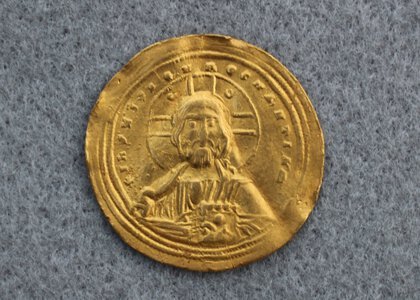
A Very Rare 1,000-Year-Old Byzantine Gold Coin Found in Norway
Approximately 1,000 years ago in Constantinople — the bustling capital of the Byzantine Empire — a small gold coin was minted.
Now, about a millennia later, the tiny treasure has been unearthed more than 1,600 miles away from its origin, according to a Nov. 30 news release from the Inlandet County Municipality.
Officials said a metal detectorist stumbled upon the artifact among the mountains in Vestre Slidre, Norway. It’s a rare discovery for Norway, and the seemingly out-of-place artifact appears to be in great condition, especially given its age.
Photos of the coin show each side’s intricate carvings. One side depicts Jesus Christ holding a Bible, while the other shows Byzantine emperors Basil II and Constantine VII, brothers who ruled together, officials said.
Each side also has an inscription. The side showing Jesus has a Latin inscription, which translates to “Jesus Christ, King of those who reign,” according to experts. The side depicting the emperors has a Greek inscription, which translates to “Basil and Constantine, emperors of the Romans.”
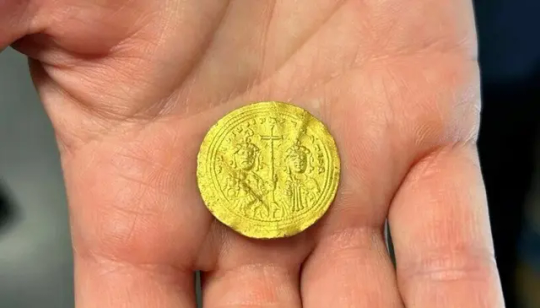
Experts said the coin was minted during Basil and Constantine’s reign, likely sometime between 977 and 1025. The dotted circles bordering the coin indicate its age.
HOW DID THE COIN MAKE IT FROM CONSTANTINOPLE TO NORWAY?
Experts have tried to determine how the coin ended up in Norway.
One hypothesis is that the artifact belonged to Harald the Ruthless — the king of Norway from 1045 until 1066, according to Britannica.
Before he was king, Harald the Ruthless, also known as Harald Hardråde, served as part of the Byzantine emperor’s guard, experts said. It was customary for guards to loot the palace after an emperor’s death, and three emperors died during Hardråde’s time as a guard.
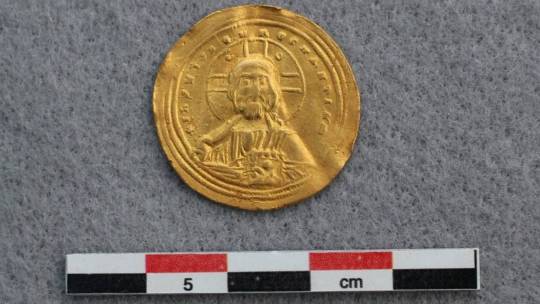
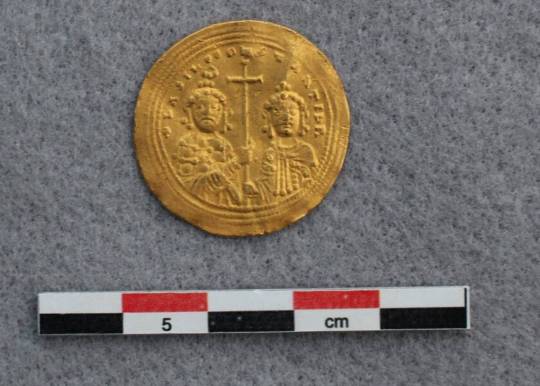
Once the coin made it back to Norway, it could have been lost along a trade or transportation route, according to experts.
Archaeologists have not had a chance to fully examine the site where the coin was found, but they are planning a broader excavation in 2024, officials said.
By Moira Ritter.
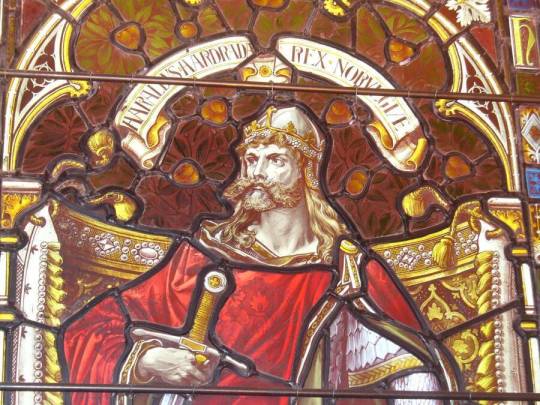
#A Very Rare 1000-Year-Old Byzantine Gold Coin Found in Norway#Constantinople#Vestre Slidre Norway#Basil II#Constantine VII#Harald the Ruthless#Harald Hardråde#Jesus#metal detecting#gold#gold coin#collectable coins#ancient artifacts#archeology#archeolgst#history#history news#ancient history#ancient culture#Byzantine Empire
354 notes
·
View notes
Text

Komsa Culture: known in Norway as the Komsakulturen, this gained its name from Mount Komsa in the Alta region of Finnmark, close to which the remnants of this culture were first discovered.
#history#historyfiles#ancient world#archaeology#mesolithic#komsa#ancient europe#mount komsa#alta#finnmark#norway
3 notes
·
View notes
Text
𝔈𝔪𝔭𝔢𝔯𝔬𝔯 - 𝔄𝔫𝔠𝔦𝔢𝔫𝔱 𝔔𝔲𝔢𝔢𝔫
#Emperor#Emperor / Wrath of the Tyrant#Ancient Queen#Release date:#September 28th#1998#Compilation#Genre:#Symphonic Black Metal#Themes:#Divination#Nature#Mythology#Individualism#Mysticism#Norway
26 notes
·
View notes
Text
who do you think told snotlout he was bi, or did he figure it out on his own
#he totally didn't figure it out on his own#(also I'm not meaning like. the label. I do not think the term bisexual existed in ancient norway)#(I mean like. telling him that he very likely is into both guys and girls equally)#talk
6 notes
·
View notes